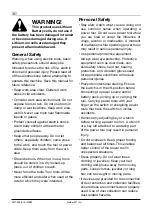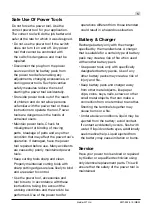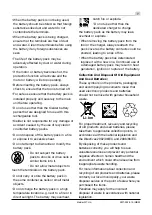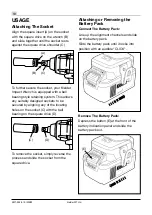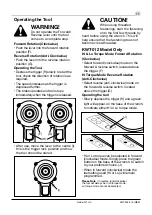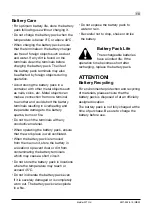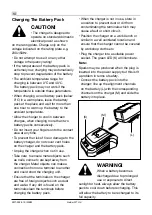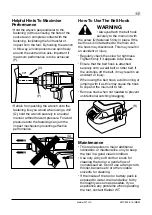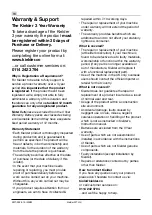
16
KWT-002-012-IMB22
Kielder WT Ltd
Operating Torque
This is affected by a wide variety of
factors:-
• Running in period - the performance of
the wrench will improve with each use
from new as internal components wear in.
During normal conditions performance will
also improve after a minute or two of use,
both the battery and internal lubrication
are at their most efficient operating
temperature warmed up from a cold start.
• Voltage – when the battery pack becomes
nearly discharged the voltage decreases
and the torque level drops.
• Run Time – longer run time results in
increased torque as indicated in CHART
1 & CHART 2, with the torque curve
flattening between 10 and around 20
seconds depending on application.
• For stubborn fastenings such as rusted
bolts increasing the duration of run time
may be beneficial as the impact motion
of the wrench will start to free the seized
threads. Always treat rusted fixtures with
a quality penetrating fluid before using
the wrench.
• Different bolt diameters – the size of the
bolt diameter affects the torque.
• Operating conditions – torque will vary
according to conditions such as surface
finish. Torque is considerably reduced
when the bolt and nut turn together.
• Socket play – Torque is reduced if a
socket of the wrong size is used, a worn
poor fitting socket is used, or a star/spline
type socket is used rather than a six sided
type on a hex-head fastening.
• Socket type, heavy duty deep impact
sockets transfer more ‘knock’ to the
fastening and will facilitate achieving
maximum torque levels.
• Trigger – torque is reduced if the unit is
used with the switch not fully depressed.
• Connecting adaptor – the torque will be
reduced if a universal joint or a connecting
adaptor is used.
• Type of fastening - the torque
performance will be affected by fastenings
such as Nyloc where the impact action
of the wrench is less effective. Or if there
is pressure on the fastening which can
cause a degree of ‘fouling’ such as a
wheel bolt fixture rather than a wheel stud
& nut. A high tensile fastening will also
react more effectively to the impact action
of this tool than a standard fastening.
• Threads which are contaminated with
dirt or damaged/strained will also affect
the rate at which the torque curve climbs.
Clean threads in good condition will allow
maximum torque to be achieved more
quickly than threads which are dirty or
fouled in some way.
Torque (Nm)
Threaded Fastening Standard Tensile
CHART 1: KWT-002 MODEL
Run Time (Sec)
0
100
200
300
400
500
5
10
15
20
25
30
M24
M20
M16
M12
M10
M14
Note: This chart refers to 1/2"
Impact wrench performance only,
3/8" offers approximately half
torque and fastening size capacity.
Torque (Nm)
Threaded Fastening Standard Tensile
CHART 2: KWT-012 MODEL
Run Time (Sec)
0
100
200
300
400
500
600
700
5
10
15
20
25
30
Note: This chart refers to
the KWT-012 Model 1/2"
Impact wrench
M24
M20
M16
M12
M10
M14



